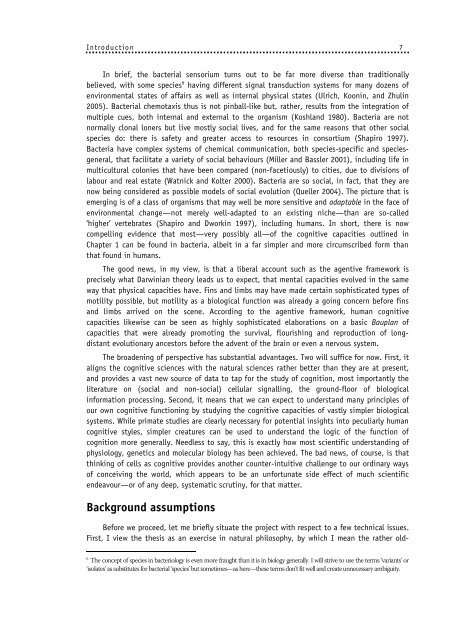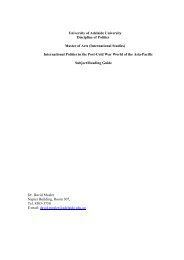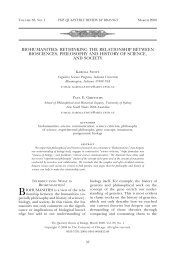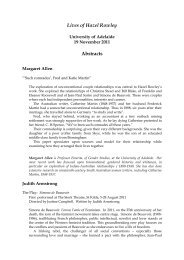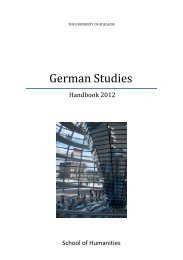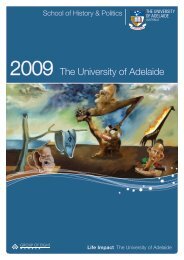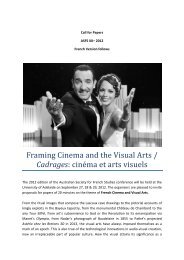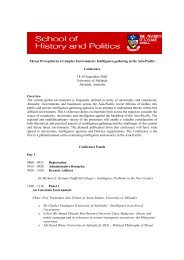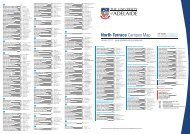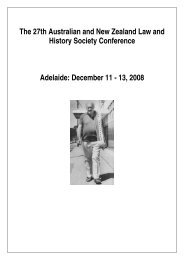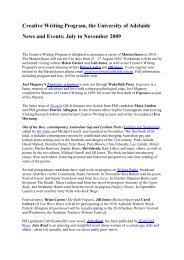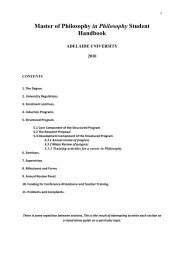Introduction - Faculty of Humanities & Social Sciences
Introduction - Faculty of Humanities & Social Sciences
Introduction - Faculty of Humanities & Social Sciences
Create successful ePaper yourself
Turn your PDF publications into a flip-book with our unique Google optimized e-Paper software.
Introdu ctio n 7<br />
In brief, the bacterial sensorium turns out to be far more diverse than traditionally<br />
believed, with some species 6 having different signal transduction systems for many dozens <strong>of</strong><br />
environmental states <strong>of</strong> affairs as well as internal physical states (Ulrich, Koonin, and Zhulin<br />
2005). Bacterial chemotaxis thus is not pinball-like but, rather, results from the integration <strong>of</strong><br />
multiple cues, both internal and external to the organism (Koshland 1980). Bacteria are not<br />
normally clonal loners but live mostly social lives, and for the same reasons that other social<br />
species do: there is safety and greater access to resources in consortium (Shapiro 1997).<br />
Bacteria have complex systems <strong>of</strong> chemical communication, both species-specific and speciesgeneral,<br />
that facilitate a variety <strong>of</strong> social behaviours (Miller and Bassler 2001), including life in<br />
multicultural colonies that have been compared (non-facetiously) to cities, due to divisions <strong>of</strong><br />
labour and real estate (Watnick and Kolter 2000). Bacteria are so social, in fact, that they are<br />
now being considered as possible models <strong>of</strong> social evolution (Queller 2004). The picture that is<br />
emerging is <strong>of</strong> a class <strong>of</strong> organisms that may well be more sensitive and adaptable in the face <strong>of</strong><br />
environmental change—not merely well-adapted to an existing niche—than are so-called<br />
‘higher’ vertebrates (Shapiro and Dworkin 1997), including humans. In short, there is now<br />
compelling evidence that most—very possibly all—<strong>of</strong> the cognitive capacities outlined in<br />
Chapter 1 can be found in bacteria, albeit in a far simpler and more circumscribed form than<br />
that found in humans.<br />
The good news, in my view, is that a liberal account such as the agentive framework is<br />
precisely what Darwinian theory leads us to expect, that mental capacities evolved in the same<br />
way that physical capacities have. Fins and limbs may have made certain sophisticated types <strong>of</strong><br />
motility possible, but motility as a biological function was already a going concern before fins<br />
and limbs arrived on the scene. According to the agentive framework, human cognitive<br />
capacities likewise can be seen as highly sophisticated elaborations on a basic Bauplan <strong>of</strong><br />
capacities that were already promoting the survival, flourishing and reproduction <strong>of</strong> longdistant<br />
evolutionary ancestors before the advent <strong>of</strong> the brain or even a nervous system.<br />
The broadening <strong>of</strong> perspective has substantial advantages. Two will suffice for now. First, it<br />
aligns the cognitive sciences with the natural sciences rather better than they are at present,<br />
and provides a vast new source <strong>of</strong> data to tap for the study <strong>of</strong> cognition, most importantly the<br />
literature on (social and non-social) cellular signalling, the ground-floor <strong>of</strong> biological<br />
information processing. Second, it means that we can expect to understand many principles <strong>of</strong><br />
our own cognitive functioning by studying the cognitive capacities <strong>of</strong> vastly simpler biological<br />
systems. While primate studies are clearly necessary for potential insights into peculiarly human<br />
cognitive styles, simpler creatures can be used to understand the logic <strong>of</strong> the function <strong>of</strong><br />
cognition more generally. Needless to say, this is exactly how most scientific understanding <strong>of</strong><br />
physiology, genetics and molecular biology has been achieved. The bad news, <strong>of</strong> course, is that<br />
thinking <strong>of</strong> cells as cognitive provides another counter-intuitive challenge to our ordinary ways<br />
<strong>of</strong> conceiving the world, which appears to be an unfortunate side effect <strong>of</strong> much scientific<br />
endeavour—or <strong>of</strong> any deep, systematic scrutiny, for that matter.<br />
Background assumptions<br />
Before we proceed, let me briefly situate the project with respect to a few technical issues.<br />
First, I view the thesis as an exercise in natural philosophy, by which I mean the rather old-<br />
6<br />
The concept <strong>of</strong> species in bacteriology is even more fraught than it is in biology generally. I will strive to use the terms ‘variants’ or<br />
‘isolates’ as substitutes for bacterial ‘species’ but sometimes—as here—these terms don’t fit well and create unnecessary ambiguity.


